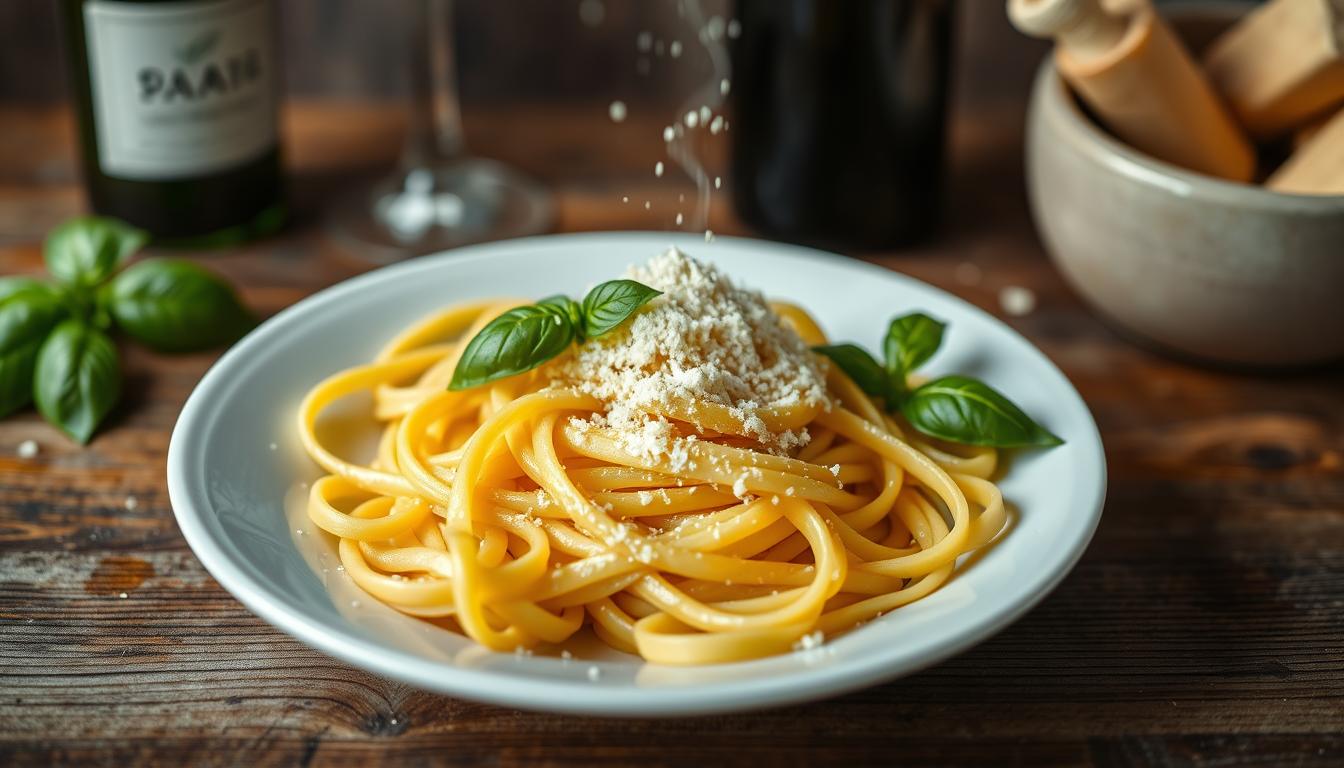Discover my authentic recipe for tagliolini, a delicate Italian pasta that’s thinner than fettuccine. Learn to make this elegant dish like a true Italian chef at home
Table of Contents
Ever wondered why authentic Italian tagliolini is so loved? This thin pasta is a true Italian cuisine gem, from the Amalfi Coast. I’ll show you how to make a delicious tagliolini al limone that feels like Italy.
What makes this dish so special? Get ready to learn the secret to making authentic Italian tagliolini at home.
Key Takeaways
- Discover the delicate essence of authentic Italian tagliolini pasta
- Learn the step-by-step process to create a perfect tagliolini al limone dish
- Explore the importance of high-quality ingredients in achieving the quintessential Italian flavor
- Understand the techniques for making fresh pasta dough and achieving the ideal texture
- Discover how to pair your homemade tagliolini with the perfect lemon butter sauce
Introduction to Traditional Italian Tagliolini
Egg pasta is a big part of Italian cuisine. It has a long history. tagliolini is a thin, long noodle. It’s like tagliatelle but even more delicate.
Tagliolini come from Emilia-Romagna and Marche in Italy. They are also called taglierini. They cook fast and soak up sauces well.
Brief History of Egg Pasta in Italian Cuisine
The tradition of making egg pasta in Italy started in the Renaissance. The first records of “tagliatelle” were in the 16th century. The classic recipe is one egg for every 100 grams of flour.
What Makes Tagliolini Special
- Tagliolini are about 6 mm (1/4 inch) wide when raw. But they should be 8 mm (5/16 inch) wide when cooked.
- Their thin, delicate nature makes them cook fast. They go well with many sauces, like pomodoro e basilico and briciole e noci.
- Tagliolini’s rough texture is great for thick sauces. These can be made with beef, veal, or pork.
Tagliolini’s versatility and rich history make them a favorite in Italian cuisine.
Essential Ingredients for Perfect Tagliolini
Making authentic Italian tagliolini needs top-notch ingredients. The dish’s heart is a mix of a few key parts. Let’s look at what you need for a memorable tagliolini al limone (tagliolini with lemon).
The base of this recipe is semolina pasta and fresh pasta. Semolina flour gives the tagliolini a firm, slightly coarse texture. Eggs and “00” flour make it delicate and velvety.
The lemon butter sauce needs fresh lemons, preferably from Italy’s Amalfi Coast. You’ll also need unsalted butter, Parmigiano Reggiano cheese, and a bit of salt to balance the taste.
| Ingredient | Quantity |
|---|---|
| Tagliolini Pasta (or Linguine/Spaghetti) | 400g (14oz) |
| Eggs | 3-4 large |
| Semolina Flour | 200g (7oz) |
| “00” Flour | 200g (7oz) |
| Lemons (from Amalfi Coast, if possible) | 2-3 |
| Unsalted Butter | 100g (3.5oz) |
| Parmigiano Reggiano Cheese | 50g (1.8oz) |
| Kosher Salt | to taste |
While fresh pasta is best, dried semolina pasta works too if needed. Choose high-quality ingredients to let the tagliolini’s flavors stand out.
Fresh vs Store-Bought Tagliolini: Making the Right Choice
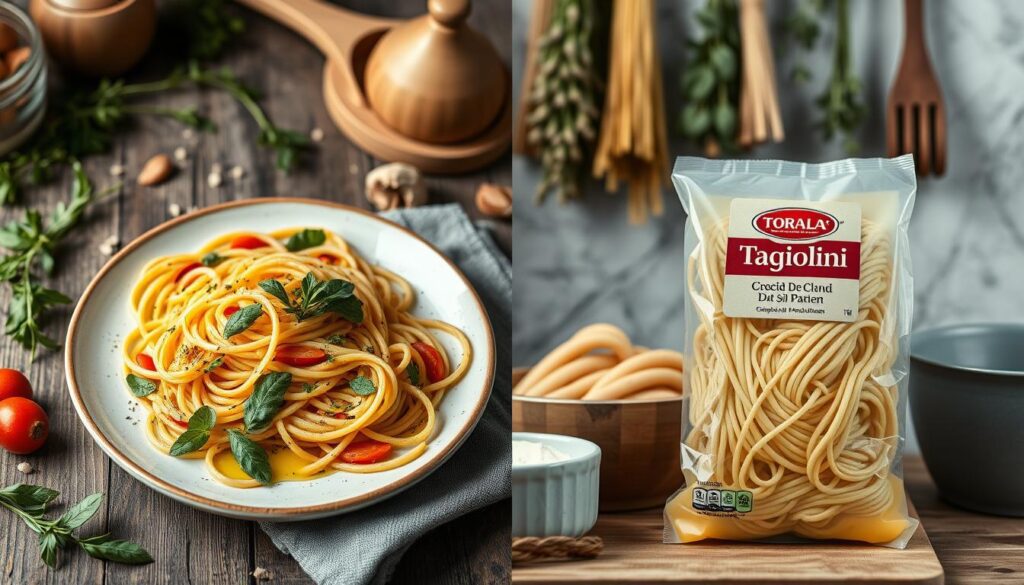
Choosing between fresh tagliolini and store-bought pasta can change your dish. Each has its own benefits. The right choice depends on the dish you want to make.
Benefits of Fresh Pasta
Fresh tagliolini is a top pick for pasta lovers. It has a unique texture and taste that store-bought can’t match. It cooks quickly, in just 2-3 minutes, perfect for light sauces like lemon butter.
Fresh tagliolini is also healthier. It has fewer calories and more protein than dried pasta. But, it has more cholesterol and sodium. So, those watching these might prefer store-bought.
When to Use Store-Bought Options
Store-bought pasta is great for some situations. It lasts longer and is cheaper, making it good for everyday meals. Some brands are also enriched with nutrients like Thiamin and Selenium.
Dry pasta works well with thick sauces. Its firmer texture holds up to strong flavors. So, it’s best for dishes like ragu or tomato-based sauces.
| Nutrition Comparison | Fresh Tagliolini | Dry Pasta |
|---|---|---|
| Calories (per cooked cup) | 184 | 224 |
| Protein (grams per cooked cup) | 7.5 | 8.2 |
| Total Fat (grams per cooked cup) | 2.5 | 1.3 |
| Cholesterol (milligrams per cooked cup) | 58 | 0 |
| Sodium (milligrams per cooked cup) | 118 | 1 |
The choice between fresh and store-bought pasta depends on your taste, the dish, and your diet. Both can make delicious pasta dishes if done right.
Kitchen Tools and Equipment Needed
To make a real Italian tagliolini dish, you need some key tools. As someone who loves cooking, I know the right tools are crucial. They help get the pasta just right in texture and taste.
A pasta machine or a strong rolling pin is essential for making thin tagliolini dough. The Copper Marcato Atlas 150 pasta machine has ten settings and tools for cutting noodles. Or, you can use a long, wooden Italian rolling pin to get the dough thin enough.
You’ll need a big pot to boil the pasta. Make sure it’s big enough for the noodles to move around. A spider strainer helps get the cooked pasta out of the pot. It keeps the cooking water for the sauce.
- Pasta machine or rolling pin for rolling out the dough
- Large pot for boiling the pasta
- Spider strainer for retrieving the cooked pasta
For the sauce, use a large sauté pan or skillet. It’s important for reducing and mixing the sauce well. A zester or grater is great for adding lemon zest. And, a cheese grater is needed for Parmigiano Reggiano cheese.
| Tool | Use |
|---|---|
| Pasta machine or rolling pin | Flatten and roll out the pasta dough |
| Large pot | Boil the pasta |
| Spider strainer | Retrieve the cooked pasta from the pot |
| Sauté pan or skillet | Cook the sauce |
| Zester or grater | Grate lemon zest |
| Cheese grater | Grate Parmigiano Reggiano cheese |
With these pasta making tools, pasta rolling gear, and pasta cutting tools, you’re ready to make delicious tagliolini at home.
Step-by-Step Pasta Dough Preparation
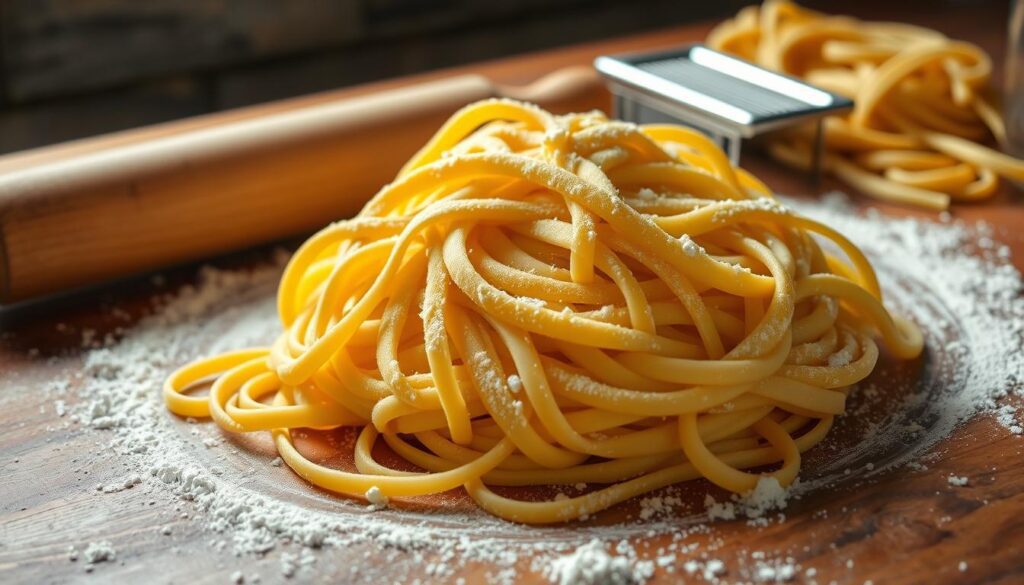
Making real homemade tagliolini begins with the right pasta dough. First, get your ingredients ready: flour, eggs, and a bit of white wine or extra virgin olive oil. The classic recipe uses about 40 egg yolks for every kilo of flour. This makes the fresh tagliolini dough both colorful and delicious.
Mixing and Kneading Techniques
Begin by mixing flour and eggs until a dough comes together. Knead the dough for 10 minutes. This makes it smooth and elastic.
Resting and Rolling Methods
After kneading, allow the dough to rest for 30 minutes. This allows the gluten to relax, making it easier to roll out. Then, split the dough into parts and roll each through a pasta machine. Keep lowering the thickness until it’s about 1mm thick, perfect for tagliolini.
Follow these steps to make tasty, fresh tagliolini. It’s all about patience, detail, and loving Italian food.
The Art of Rolling and Cutting Tagliolini
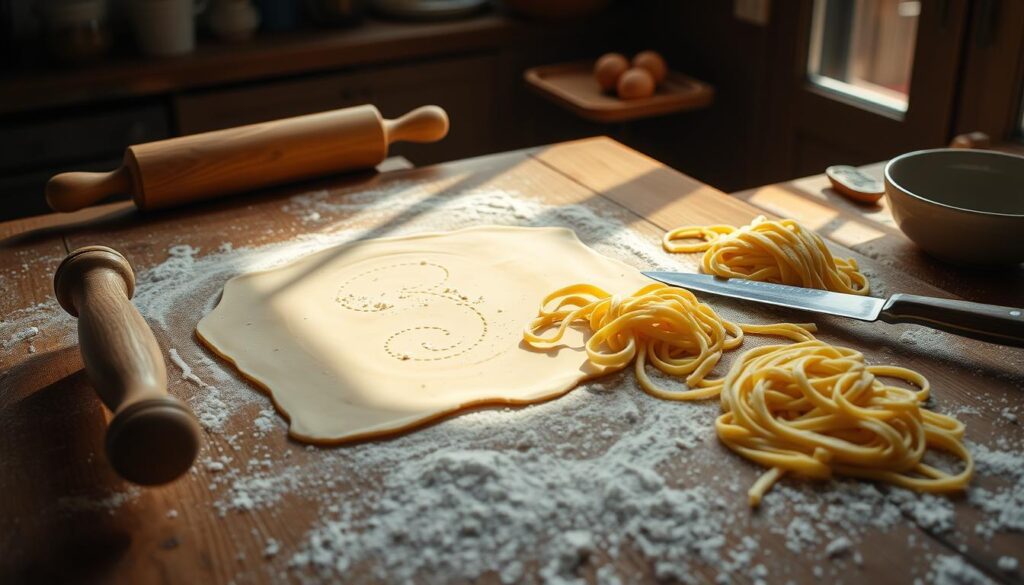
Making perfect tagliolini, the thin Italian egg pasta, is a labor of love. It’s key for many classic dishes. Learning to roll and cut it is vital for pasta lovers.
Start by rolling out the pasta dough thinly and evenly. Use a pasta machine or a strong rolling pin. Aim for a thickness of about 1 millimeter. This thinness is key for tagliolini’s look and feel.
After rolling, let the sheets rest and dry a bit. This step relaxes the gluten, making for a clean cut. Use a sharp knife or a pasta machine’s cutter to make long, thin strips, about 3 millimeters wide.
To stop the pasta from sticking, dust it lightly with flour. This keeps the strands from clumping. It makes cooking and serving them easier.
Rolling and cutting tagliolini needs patience, practice, and attention to detail. Mastering this skill will help you make perfect pasta dishes. These dishes will truly capture the spirit of Italian cuisine.
| Pasta Cutting Dimensions | Tagliolini | Fettuccine |
|---|---|---|
| Width | 3mm | 8mm |
| Thickness | 1mm | 2mm |
Classic Lemon Butter Sauce (Tagliolini al Limone)
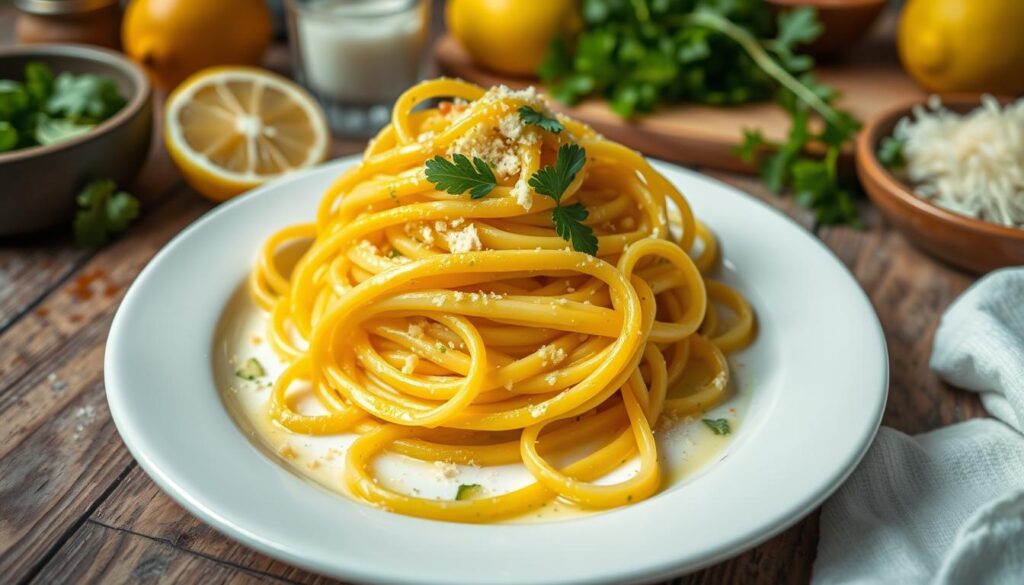
Making the perfect tagliolini al limone is an art. It comes from Southern Italy’s sunny lands. The key is using the right ingredients, and lemons are the star.
Ingredient Selection Tips
For top tagliolini al limone, choose lemons with thick skin. The Amalfi Coast lemons are best. They have strong zest and juice, adding deep flavor to your sauce.
Sauce Preparation Steps
- Begin by melting butter in a pan over medium heat.
- Add the grated zest and juice from 2-3 Amalfi lemons once the butter melts.
- Season with a pinch of salt, to taste.
- While the pasta cooks, move it to the lemon butter sauce.
- Toss the pasta with the sauce. Add pasta water for a creamy texture.
- Stir in Parmigiano Reggiano cheese. This makes the sauce coat the pasta well.
This makes a simple yet flavorful tagliolini al limone. It highlights the Amalfi lemons’ bright, tangy taste. Serve it warm, with fresh thyme or basil for extra fragrance.
Alternative Sauce Variations
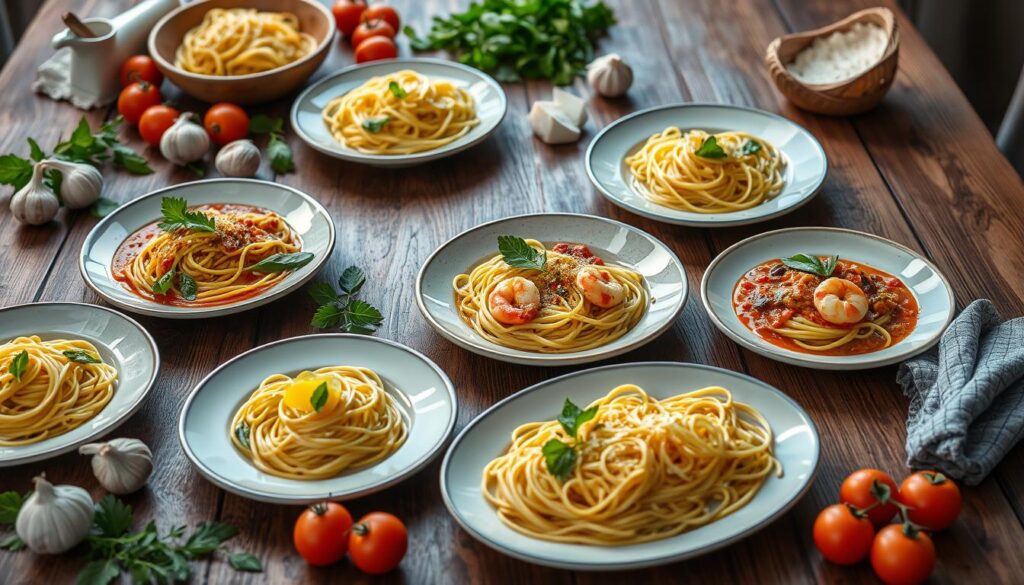
Tagliolini pasta is great with many sauces, not just lemon butter. Try a prosciutto and Parmigiano Reggiano sauce for a rich taste. Or, go for a light cherry tomato sauce for a summer feel.
Adding herbs like sage, basil, or arugula can make your dish more interesting. These herbs add depth and complexity.
For a bit of crunch, add toasted nuts like pine nuts or pistachios. They make your dish look good and feel different from the pasta.
Tagliolini’s thin shape makes it perfect for many pasta sauce recipes. Try different tagliolini variations to find your favorite. You can go from creamy to light and refreshing.
| Sauce Variation | Key Ingredients | Flavor Profile |
|---|---|---|
| Prosciutto and Parmigiano Reggiano | Prosciutto, Parmigiano Reggiano, cream or butter | Rich, savory |
| Cherry Tomato | Cherry tomatoes, garlic, basil, olive oil | Fresh, summery |
| Herb-Infused | Sage, basil, arugula, pine nuts | Aromatic, nutty |
Trying different tagliolini variations and pasta sauce recipes can make your dishes stand out. Be creative and enjoy the process!
Proper Cooking Techniques for Al Dente Pasta
To make your pasta just right, focus on water temperature, cooking time, and salt. These are key to a delicious Italian dish.
Water Temperature and Timing
First, boil a big pot of water fast. It should boil well before adding pasta. Fresh tagliolini cooks fast, in 2-3 minutes. Dried pasta takes 7-9 minutes.
Check the pasta often by biting it. This ensures it’s firm and chewy.
Salt Ratio Guidelines
Season the water with 1 tablespoon of salt for every 4 liters (1 gallon). This seasons the al dente pasta inside. Remember, pasta cooks a bit more after draining.
By following these tips, your pasta will be perfect. With practice, you’ll make al dente pasta dishes like a pro.
Plating and Presentation Tips
Making your homemade tagliolini look good is as important as making it taste great. We eat with our eyes first! A few simple steps can make your tagliolini look like a work of art.
Use warm plates to serve your pasta. This keeps it at the right temperature and texture. Twirl the tagliolini with tongs or a fork to make it look nice on the plate. Add a bit of lemon zest, Parmigiano Reggiano, and fresh herbs for extra flair.
For tagliolini al limone, a single sage leaf is a beautiful and tasty touch. Serve your pasta right away for the best taste and texture.
Chef Amandeep Singh says to use simple, neutral plates to let the dish’s colors pop. Chef Sandeep Kalra agrees, saying the plate color should match the dish’s colors and textures. Chef Simran Singh Thapar adds that texture variation is key for a stunning presentation.
Let the tagliolini be the star. Use garnishes and sauces to make the dish look even better, as Chef Sandeep suggests. With a little care, your homemade tagliolini will delight your senses.
Wine Pairing Suggestions
Choosing the right wine for tagliolini is key. Think about the dish’s main ingredients and tastes. For tagliolini al limone, a crisp white wine is best. Vermentino from Liguria or Falanghina from Campania are great picks.
For richer tagliolini, like alla parmigiana, a light red or a full-bodied white works well. A Sangiovese or Verdicchio can balance the dish’s flavors nicely.
With tomato-based sauces, try Primitivo or Montepulciano d’Abruzzo. These wines match the tomatoes’ acidity and flavor. Sangiovese or Rhône blends are also good choices.
For cheese-based dishes, like cacio e pepe, creamy wines are best. Trebbiano di Lugana or Chardonnay pairs well with the cheese.
Seafood or pesto sauces call for light, delicate wines. Pinot Grigio, Verdicchio, or Fiano d’Avellino are perfect. They enhance the pasta and sauce’s flavors.
The aim is to match the wine with the pasta’s texture and taste. Try different Italian wines to find the best Italian wine pairing for your pasta wine suggestions.
Common Mistakes to Avoid
Making perfect tagliolini, the long, thin egg pasta from Italy, is like an art. Even experienced cooks can make mistakes. Knowing these common errors helps make sure your tagliolini is always perfect.
Dough Consistency Issues
Getting the dough right is key for making tagliolini. If you work the dough too much, it gets tough. If not enough, it’s crumbly. Knead it just enough to make it strong, then let it rest before rolling and cutting.
Cooking Time Errors
Cooking pasta at the right time is crucial. If it’s not cooked enough, it’s chewy. Too long, and it’s mushy. Check the package, but taste it a bit early for the best al dente feel. Don’t rinse it after cooking, as it loses the starch for sauce.
Avoiding these pasta making mistakes and tagliolini cooking errors helps you make a delicious Italian dish.
| Common Pasta Cooking Mistakes | Proper Techniques |
|---|---|
| Cooking pasta in a pot that is too small | Use 5-6 quarts of water per pound of pasta |
| Not adding salt to the cooking water | Add 1-2 tablespoons of salt to boiling water |
| Adding pasta to the water before it has boiled | Wait for water to come to a rapid boil before adding pasta |
| Adding oil to the water | Avoid adding oil, as it can make the pasta slippery |
| Not stirring pasta frequently during cooking | Stir pasta often to prevent sticking and ensure even cooking |
| Undercooking or overcooking pasta | Test pasta a minute or two earlier than package directions |
| Rinsing cooked pasta | Avoid rinsing, as it washes away the starch needed for sauce adherence |
Conclusion
Learning to make authentic Italian tagliolini is a journey. It lets me create a homemade pasta dish that’s truly special. Whether I use fresh or dried pasta, the secret is in the quality of ingredients and techniques.
Trying out different sauces and pairings helps me find my favorite. This way, I can enjoy the true taste of Italian food.
With time and effort, I can make tagliolini as good as in a restaurant. This pasta’s rich history and versatility make it a fun challenge. By mastering traditional ways of making tagliolini, I can enjoy the real flavors of Italy.
My quest to master authentic Italian tagliolini is full of surprises. It’s rewarding to make a homemade pasta dish that’s as good as any restaurant’s. I’m excited to keep improving and trying new flavors to make this recipe my own.

